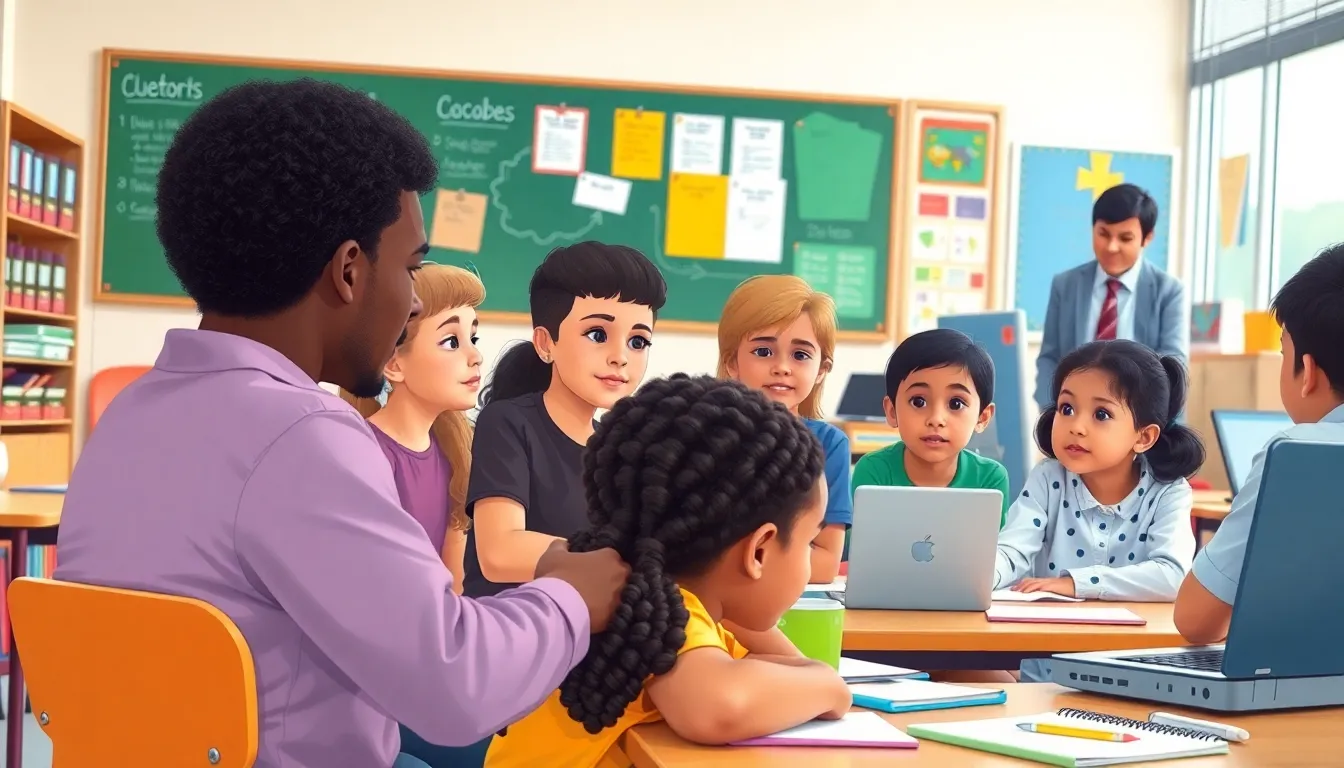Table of Contents
ToggleIn today’s fast-paced world, K-12 education faces challenges that would make even the most seasoned educators scratch their heads. From funding woes to the endless debate over curriculum standards, the landscape is as tumultuous as a game of dodgeball in a crowded gym. It’s not just about teaching kids to read or solve math problems anymore; it’s about preparing them for a future that seems to change every five minutes.
As schools navigate these uncharted waters, they must also tackle issues like mental health support, technology integration, and equity in education. It’s a tall order, but hey, who doesn’t love a good challenge? Dive into the current issues in K-12 education today, and discover how these hurdles can be transformed into stepping stones for a brighter and more inclusive educational experience.
Overview of Current Issues in K-12 Education Today
K-12 education faces numerous challenges as it adapts to a changing landscape. Funding disparities significantly affect school resources across districts. Curriculum standards vary widely, leading to inconsistency in educational quality. Mental health support remains critical, with many students lacking access to necessary services.
Technology integration becomes essential in today’s classrooms, yet many schools struggle to provide adequate training for educators. Educational equity presents another pressing issue, as marginalized groups often experience limited access to quality education. Teacher burnout has escalated due to increased demands and challenging working conditions.
Student assessment methods contribute to concerns about fairness and effectiveness. Traditional testing practices fail to capture a student’s full potential or diverse learning styles. Parental engagement also fluctuates, with varying degrees of participation impacting student success.
Polarized viewpoints on educational content further complicate discussions around curriculum choices. Social issues increasingly intersect with education, influencing classroom dynamics. The ongoing impact of the pandemic has prompted discussions about alternative learning models, including remote and hybrid approaches.
Finally, the need for professional development becomes evident as educators seek to adapt to these rapidly evolving conditions. Addressing these interconnected challenges can create opportunities for transformational improvements in K-12 education.
Funding and Resource Allocation

Funding and resource allocation remain critical issues in K-12 education today. Disparities in these areas directly affect the quality of education students receive across different regions.
Inequities in School Funding
Inequities in school funding create significant challenges for many districts. Public schools primarily rely on local property taxes for budget allocations. Wealthy areas often have access to greater resources than underserved neighborhoods. According to the National Center for Education Statistics, schools in high-poverty areas receive over $1,000 less per student than those in affluent areas. Consequently, underfunded schools struggle to provide essential facilities, technology, and educational materials. Teachers in these districts often lack adequate support, leading to a disparity in educational quality. Moreover, students from marginalized communities feel the impact of these inequities more severely.
Impact of Budget Cuts
Budget cuts consistently affect K-12 education, leading to resource shortages. As states face budget constraints, many prioritize other sectors over education. Schools may cut programs viewed as nonessential, such as arts and extracurricular activities. A 2021 survey indicated that about 80% of school leaders noted that budget cuts significantly impacted their curriculum choices. Teachers often experience increased class sizes and reduced materials, hindering effective instruction. Students, in turn, lose access to comprehensive educational experiences. Long-term effects of these cuts can diminish student engagement and achievement. Addressing budget cut impacts remains vital for fostering a fair education system.
Curriculum and Standards
Curriculum and standards face significant scrutiny in today’s educational landscape. Many agree that standardized testing practices create a narrow view of student abilities.
Standardized Testing Controversies
Standardized tests often don’t reflect a student’s comprehensive understanding. Critics point out that these assessments can reinforce inequities by failing to accommodate diverse learning styles. Schools are pressured to prioritize test preparation over holistic learning. Consequently, this pressure may lead to teaching to the test, diminishing creative instruction methods. Some educators argue that alternative assessments could provide a clearer picture of student progress. Reports also indicate that students from marginalized groups experience heightened stress levels during testing periods, compounding existing challenges in educational equity.
Relevance of Curriculum to Today’s Society
Today’s curriculum must align closely with the evolving landscape of society. Many experts emphasize integrating social issues, such as environmental sustainability and digital literacy, into lesson plans. This alignment promotes critical thinking and equips students for future challenges. Educational leaders call for curricula that foster cultural competency and global awareness. Ensuring that course content is relevant helps engage students in meaningful ways. Efforts must focus on preparing learners for a rapidly changing job market, which increasingly values skills over rote memorization.
Teacher Shortages and Retention
Teacher shortages and retention pose significant challenges for K-12 education, impacting student learning and overall educational quality. High levels of stress, coupled with inadequate support, contribute to increasing burnout among educators.
Causes of Teacher Burnout
Increased workloads strain teachers, as they often juggle multiple responsibilities without corresponding resources. Limited administrative support heightens feelings of isolation among educators. Emotional demands of addressing diverse student needs contribute to overwhelming stress levels. Insufficient professional development opportunities leave teachers unprepared for evolving classroom dynamics. Additionally, low salaries relative to demands push educators to seek alternative careers, exacerbating turnover rates.
Strategies for Retaining Educators
Implementing mentorship programs can foster a supportive environment for new educators. Regular professional development tailored to teachers’ needs boosts morale and enhances skill sets. Offering competitive salaries and benefits attracts and retains qualified staff. Building a positive school culture encourages collaboration and reduces feelings of isolation. Creating opportunities for teacher input in decision-making processes empowers educators, increasing job satisfaction. A focus on wellness initiatives addresses mental health, further supporting retention efforts.
Technology in the Classroom
Technology integration in K-12 education transforms traditional approaches to learning. Schools increasingly incorporate educational technology tools to enhance student engagement and learning outcomes.
Integration of EdTech
Adoption of educational technology, or EdTech, provides innovative resources to support diverse learning styles. Teachers now use digital platforms and interactive applications to foster collaboration and enrich classroom experiences. Data shows that students who engage with technology demonstrate improved motivation and achievement. Schools invest in training programs, ensuring educators effectively utilize these tools. When teachers feel equipped to integrate technology, students gain access to personalized learning opportunities.
Challenges of Remote Learning
Remote learning presents unique challenges for educators and students. Lack of reliable internet access affects participation, especially in low-income areas. Students may struggle with self-discipline and time management outside a structured environment. Many educators report difficulties in maintaining student engagement during virtual classes. Increased screen time poses concerns regarding students’ well-being and mental health. Schools must find solutions to address these issues and provide support, facilitating a better learning experience in remote settings.
Mental Health and Student Well-Being
Mental health issues among students continue to rise significantly, impacting their academic performance and overall well-being. According to recent studies, approximately 1 in 5 students experience mental health challenges. Increased stress levels, anxiety, and depression affect students of all ages, particularly during transitions and post-pandemic recovery. Trauma, family issues, and social pressures compound these difficulties, highlighting an urgent need for intervention. Schools recognize that mental health directly influences learning and engagement, making it essential to address these challenges effectively.
Rising Mental Health Issues among Students
Rising rates of anxiety and depression among K-12 students significantly affect their learning environments. Statistics show that 20% of students deal with mental health issues, leading to increased absenteeism and disengagement in school activities. Resilience in coping with academic pressures influences many students. Additionally, societal influences like social media exacerbate feelings of inadequacy and isolation. Teachers increasingly identify signs of distress in their classrooms yet often lack the training to support these students adequately. Schools must prioritize mental health to foster healthier learning environments.
School Support Systems
School support systems play a crucial role in addressing mental health concerns. Counselors and psychologists in schools provide essential resources for students in need. Collaboration with community organizations can expand access to mental health services, offering students comprehensive care. Programs that promote social-emotional learning help build resilience and coping strategies among students. Effective staff training ensures educators recognize signs of mental illness and respond appropriately. Funding for mental health initiatives in schools enhances the availability of support resources, making it easier for students to access help when necessary.
K-12 education today faces a myriad of challenges that demand urgent attention and innovative solutions. Addressing funding disparities and ensuring equitable access to resources are crucial steps toward leveling the playing field for all students. The integration of technology and the emphasis on mental health support are vital for fostering an engaging and supportive learning environment.
As educators navigate these complex issues, the need for professional development and collaboration becomes increasingly important. By prioritizing teacher well-being and promoting diverse learning approaches, schools can create a more inclusive atmosphere that nurtures every student’s potential. Ultimately, tackling these current issues will pave the way for a brighter future in education, benefiting students, teachers, and communities alike.







